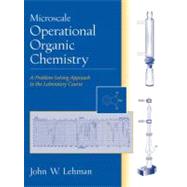
| Preface | |
| Introduction | |
| Mastering the Operations | |
| Learning Basic Operations | |
| The Effect of pH on a Food Preservative | |
| Extraction and Evaporation | |
| Separating the Components of Panacetin | |
| Recrystallization and Melting-Point Measurement | |
| Identifying a Constituent of Panacetin | |
| Heating under Reflux | |
| Simple Distillation, Gas Chromatography | |
| Preparation of Synthetic Banana Oil | |
| Fractional Distillation | |
| Addition, Mixing, Sublimation | |
| Preparation of Camphor | |
| Boiling Point, Refractive Index | |
| Identification of a Petroleum Hydrocarbon | |
| Column Chromatography, UV-VIS Spectrometry | |
| Isolation and Isomerization of Lycopene from Tomato Paste | |
| Steam Distillation, Infrared Spectrometry | |
| Isolation and Identification of the Major Constituent of Clove Oil | |
| Thin-Layer Chromatography, NMR Spectrometry | |
| Vacuum Distillation, Optical Rotation | |
| Optical Activity of a-Pinene | |
| Correlated Laboratory Experiments | |
| Investigation of a Chemical Bond by Infrared Spectrometry | |
| Properties of Common Functional Groups | |
| Thin-Layer Chromatographic Analysis of Drug Components | |
| Separation of an Alkane Clathrate | |
| Isomers and Isomerization Reactions | |
| Structures and Properties of Stereoisomers | |
| Bridgehead Reactivity in an SN1 Solvolysis Reaction | |
| Reaction of Iodoethane with Saccharin, an Ambident Nucleophile | |
| Dehydration of Methylcyclohexanols | |
| Synthesis of 7,7-Dichloronorcarane Using a Phase-Transfer Catalyst | |
| Stereochemistry of the Addition of Bromine to trans-Cinnamic Acid | |
| Hydration of a Difunctional Alkyne | |
| Preparation of Bromotriphenylmethane and the Trityl Free Radical | |
| Chain-Growth Polymerization of Styrene and Methyl Methacrylate | |
| Synthesis of Ethanol by Fermentation | |
| Reaction of Butanols with Hydrobromic Acid | |
| Borohydride Reduction of Vanillin to Vanillyl Alcohol | |
| Synthesis of Triphenylmethanol and the Trityl Carbocation | |
| Identification of a Conjugated Diene from Eucalyptus Oil | |
| Spectral Identification of Monoterpenoids | |
| Synthesis and Spectral Analysis of Aspirin | |
| Preparation of Nonbenzenoid Aromatic Compounds | |
| Mechanism of the Nitration of Arenes by Nitronium Fluoborate | |
| Friedel-Crafts Acylation of Anisole | |
| Structure of a Natural Product in Anise Oil | |
| Identification of an Oxygen-Containing Organic Compound | |
| Wittig Synthesis of 1,4-Diphenyl-1,3-Butadiene | |
| Effect of Reaction Conditions on the Condensation of Furfural with Cyclopentanone | |
| Haloform Oxidation of 4'-Methoxyacetophenone | |
| Electronic Effect of a para-Iodo Substituent | |
| Synthesis and Identification of an Unknown Carboxylic Acid | |
| Preparation of the Insect Repellent N,N-Diethyl-meta-toluamide | |
| Synthesis of 2-Acetylcyclohexanone by the Stork Reaction | |
| Synthesis of Dimedone and Measurement of its Tautomeric Equilibrium Constant | |
| Preparation of Para Red and Related Azo Dyes | |
| Reaction of Phthalimide with Sodium Hypochlorite | |
| Identification of an Unknown Amine | |
| Preparation and Mass Spectrum of 2-Phenylindole | |
| Nucleophilic Strength and Reactivity in SNAr Reactions | |
| Structure of an Unknown d-Hexose | |
| Fatty Acid Content o | |
| Table of Contents provided by Publisher. All Rights Reserved. |
The New copy of this book will include any supplemental materials advertised. Please check the title of the book to determine if it should include any access cards, study guides, lab manuals, CDs, etc.
The Used, Rental and eBook copies of this book are not guaranteed to include any supplemental materials. Typically, only the book itself is included. This is true even if the title states it includes any access cards, study guides, lab manuals, CDs, etc.